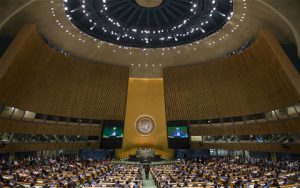Global attention turns to the United Nations headquarters on September 23 as more than 120 heads of state and government gather to give a push to stalled climate negotiations. The heads of the Indian and Chinese governments will be conspicuous by their absence.
Observers of climate negotiations are hoping that industrialised countries will commit enough funding and help with technology transfer to reduce the differences on the table when the formal climate negotiations resume this December.
The UN secretary general has convened this special summit with two goals. A few days before the summit, Ban Ki-moon spelled them out: “To mobilise political will for a universal and meaningful climate agreement next year in Paris; and second to generate ambitious steps to reduce greenhouse-gas emissions and strengthen resilience.”
Neither will happen without reducing the differences between rich and poor nations. Industrialised countries, led by the US, are pressing hard for all countries to spell out what they will do to mitigate greenhouse-gas emissions. Developing countries – sometimes led by China and India, and nowadays more often by India alone – are equally clear that rich nations must take the lead in mitigation and must help poor nations with money and technology.
Tuesday’s summit is a major effort to push governments so that they reduce these differences. The UN secretary general is being helped in this push by what is being billed as the “largest climate march in history” by a coalition of NGOs. The main march is scheduled in New York on Sunday, and will be joined by Ban-Ki Moon. Supporting marches are planned in 150 cities across the globe, including New Delhi.
The summit is also being backed by a large number of business leaders, who are expected to announce ambitious plans to tackle climate change at their levels – at an event to be held on the same day and at the same UN headquarters. Ban Ki-moon said: “We are anticipating an impressive turnout of leaders from government, business, finance and civil society. Most important, we are expecting significant commitments and progress.”
Asked to spell out his expectations from the summit, the Ban said, “First of all, in cutting emissions, there should be a firm commitment that we should reduce greenhouse-gas emissions so that we will be able to contain the global temperature rise within two degrees Celsius.
“I expect that many countries’ leaders will announce that their bold and ambitious target with some financial support. And there is a heightened awareness, even on the private companies, that there should be some pricing on carbon. But this is up to the member states, which they will have to discuss.”
Ban said that while Tuesday’s summit would be not be part of climate negotiations, “whatever agreement or understanding will be made here, will be reflected in the UNFCCC [United Nations Framework Convention on Climate Change] negotiation process.”
While countries continue to bicker about climate targets and financial pledges for the Green Climate Fund to help developing countries cope with climate change, 340 global institutional investors representing over US$24 trillion in assets have called on government leaders to provide stable, reliable and economically meaningful carbon pricing.
"Gaps, weaknesses and delays in climate change and clean energy policies will increase the risks to our investments as a result of the physical impacts of climate change, and will increase the likelihood that more radical policy measures will be required to reduce greenhouse-gas emissions," said a joint statement by four investor groups – Ceres’ Investor Network on Climate Risk (INCR) in the US, the European Institutional Investors Group on Climate Change (IIGCC), the Investors Group on Climate Change (IGCC) in Australia and New Zealand, and the Asia Investor Group on Climate Change (AIGCC) . "Stronger political leadership and more ambitious policies are needed in order for us to scale up our investments," added the investors.
According to the International Energy Agency, the world must invest at least an additional US$1 trillion per year into clean energy by 2050 if the average temperature rise across the globe is to be held within two degrees Celsius, thus avoiding the worst impacts of climate change on the environment, health and global economy. Yet global investment in clean energy was just US$254 billion in 2013.








